“Obesity isn’t as cool as it used to be, back in the earlier centuries. Before it was a reflection on your gross income, and now it’s just gross.”
Quote by Jarod Kintz.
Have you ever felt that you are gaining weight? Do you spend more time in front of the mirror focussing on the side pose?
This article is all about obesity, tools to measure obesity, understand the dangers of obesity and the steps to prevent and treat it.
What is Obesity?
The bulk of our human body is made up of bones, muscles and several other tissues.The various types of tissues in the body include the fatty tissue and tissues making up the internal organs. Fat tissues are laid down with millions of fat cells , also called as the adipocytes. Everybody knows where in the human body the fatty tissues are commonly seen.
An abnormal growth of the fatty tissue in our body is called as “Obesity”.
This can happen in 3 ways. There could be either an increase in the number of fat cells in the tissues or the size of the individual fat cells could be increased or there can be a combination of both the above situations.
Fat deposition in individuals varies in their distribution too.
In some persons the bulk of the fat gets deposited in the abdominal area. This type of obesity is called Android Obesity (male type). This is the dangerous type of obesity as it is associated with many other diseases.
In certain other persons there is an even and more peripheral distribution of fat, rather than getting accumulated in one single area. This type of obesity is called the Gynoid (female type) Obesity which is the less serious type.
Now the major question in your minds would be whether you are obese or not. One can easily find out the answer to this question by doing a simple math equation. It is known as the “Body Mass Index”.
Body Mass Index (BMI)
BMI is the simplest tool used to classify underweight, overweight and obesity.It is defined as weight in kilograms divided by the square of the height measured in metres.
Not a math lover? Let me explain this with the help of a simple example.
If the weight of the person is 75 kilograms and height is 1.75 metres,
BMI is calculated as :
First we will find the square of person’s height i.e, 1.75×1.75=3.0625
Then BMI will be 75/3.0625 = 24.489
CATEGORY BMI Underweight less than 18.5 Normal 18.5 to 24.99 Overweight more than 25 Pre-Obese 25 to 29.99 Obese Class I 30 to 34.99 Obese Class II 35 to 39.99 Obese Class III more than 40
Body Volume Index (BVI)
Body Mass Index (BMI) and waist circumference (WC) are the two indices widely used to assess obesity. The major drawback of BMI is that it does not take into account fat and muscle distribution or allow for distinctions between gender, age or ethnicity. Waist circumference is a good tool to measure abdominal fat distribution, but chances of operator errors are higher.
Body Volume Index (BVI) is a totally new concept using a 3D body scanner. It uses different softwares to measure total body volume and 8 body segment volumes, including abdomen. Thus helps in identifying obesity in persons with similar BMI.
Dangers of Obesity
Obesity is associated with many diseases. I have already written about some of those diseases. I recommend you to read those articles which I have linked below.
The major risks of obesity are the increases chances of developing Diabetes, Hypertension, Insulin resistance, High blood cholesterol, gall bladder diseases, and breathlessness.
Risks of Coronary Heart Diseases, joint pain, gout, arthritis, infertility, cancer, are also higher if you are obese.
Childhood obesity is more dangerous as it is associated with premature death, disability in adulthood, and other cardiovascular diseases.
Steps to Prevent Obesity
There are no shortcuts to prevent and treat obesity. The main principles of preventing obesity are to adopt strict dietary changes and to increase physical activity.
- Reduce sugars, chocolates and food rich in carbohydrates and fats.
- Increase the fibre content in your diet
- Regular physical exercises
- Drugs to suppress appetite (consult your doctor)
- Surgical treatments like Gastric bypass, Gastroplasty
Enrolling in an obesity control programme with high motivation is the right step to take. Quick results should not be anticipated.even if you are strictly adhering to the programme.
How helpful was this article? Do let us know by giving your feedback in the “Comments” below.
Image credits : Mike Licht and Jason Rogers
